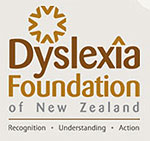Dyslexia - The Problem
Dyslexics experience great difficulty in thinking with the sounds of words when they are reading - they typically think instead with the picture the word gives them. This is why they can often read "big" words like hippopotamus, which has a picture to go with it, but are continually tripped up by the little words (commonly known as the "high frequency" words) which have no pictures, and that they are just expected to know. These high frequency words make up apporoximately 70% of what we read, and 90% of what children read when they start school.
Because they think in pictures, it is sometimes hard to understand letters, numbers, symbols, and written words. Problems arise when they are learning to read and write, and complete mathematical equations. It is easy to picture a mouse or a bed - however, there are over 200 common, everyday, little words we use frequently that do not have a picture e.g. a, is, on, the - these are the words that cause blanks when reading for understanding, and cause that feeling of confusion so common to people with dyslexia.

If we are reading for understanding, and that is the purpose of all reading, then in the above-illustrated scenario the mouse should be on the bed in the last clip - it is not there!
Words, letters and numbers and symbols that have no related picture cause confusion in most dyslexic individuals. This leads to incorrect information being absorbed, and frustration experienced when mistakes are made.
Confusion is at the root of the problems of dyslexia.


